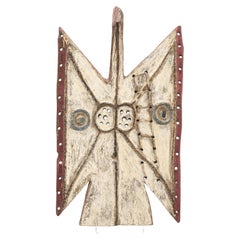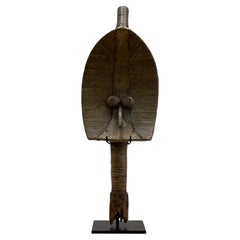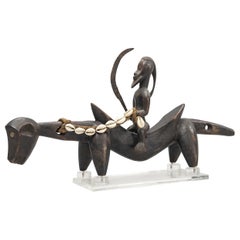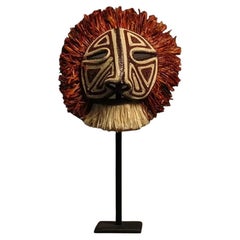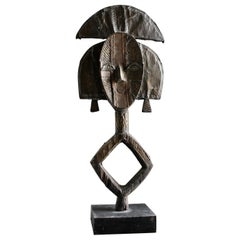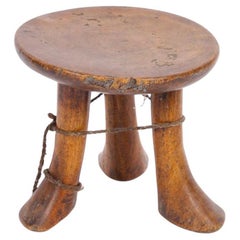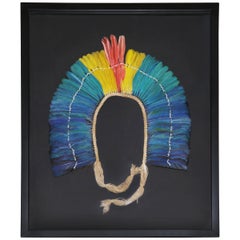Paris - Tribal Art
to
741
529
15
3
4
11
3
4
7
1
13
5
3
3
3
14
14
5
3
2
18
17
18
Item Ships From: Paris
Oman, Silver & Gold Necklace with Amulet Box, 19th Century
Located in PARIS, FR
Stunning and rare Omani tribal necklace in gold and silver featuring eight Burgau thalers dated 1780 and a large amulet box (Hirz) also in gold and silver. 19th century.
Very good condition. Preserved and professionally framed.
Dimensions of the necklace: 52 x 30 x 3
Dimensions of the frame: 70 x 47 x 5
Secure shipping.
This fine Omani necklace of silver and gold comprises two strands of spiky, seed pod-like silver beads; gold-wrapped beads; eight silver Maria Theresa thaler coins; and a large silver and gold amulet box, with multiple chain tassels each of which finishes with a square-shaped pendant cut from sheet silver.
The cigar-shaped amulet box called hirz would have contained some Koranic verse or religious text.
Such a spectacular display of wealth would only have been worn at times of important festivities such as marriage celebrations.
Maria Theresa thalers were made in Austria since the reign of Empress Maria Theresa of the Austro-Hungarian Empire. The Empress died in 1780 and since that time, all thalers that were subsequently struck were minted with that date regardless of the actual year that they were produced. The coins achieved such a level of trust for their silver content (which is 83.3% silver) in the Middle East that neither the design not the date was varied, and so for more than 200 years the coins were used as an international currency among the tribes and the states of the Middle East, in much the same way as the Spanish dollar was used as an international currency at the time elsewhere. The thalers were used to complete most important transactions locally and were also given as dowries. They were also an important source of silver and were melted locally for jewellery.
The coins made their way to the ports of the Red Sea, Egypt and northern Africa from the ports of Genoa, Trieste, Livorno and Marseille. European traders used the coins to buy precious materials from the Gulf and northern Africa which it desired – commodities such as spices, coffee, gum Arabic, indigo, pearls, and tortoise shell.
The importance and the beauty of the coins saw them incorporated into local jewellery most particularly in Oman and Yemen.
References
Al-Jadir, S., Arab & Islamic Silver, Stacey International, 1981.
Harrigan, P., ‘Tales of a Thaler’, Saudi Aramco World, January/February 2003.
Hawley, R., Omani Silver, Longman, 1978.
Hawley, R., Silver: The Traditional Art of Oman, Stacey International, 2000.
Rajab, J.S., Silver Jewellery of Oman, Tareq Rajab Museum, 1998.
Ransom, M., Silver Treasures from the Land of Sheba: Regional Yemeni Jewelry...
Category
19th Century Omani Antique Paris - Tribal Art
Materials
Gold, Silver
African mask Toussiana bird Burkina Faso Mid XXem
Located in Paris, FR
Toussiana Plank Bird from Burkina Faso Mid XXem
Provenance: private Swedish collection , auction
The TOUSSIAN live in the Southwest of Burkina Faso. The mask presented here is a Loni...
Category
Mid-20th Century Burkinabe Tribal Paris - Tribal Art
Materials
Wood
Contemporary Kayapo-Style Artwork Headdress With Moulting Feathers
Located in Paris, FR
Headdress in the style of Kayapo Amazonian Indian Tribal pieces, under frame made with moulting feathers sourced in France of blue Macaw feathers, and other South American bird feath...
Category
21st Century and Contemporary French Tribal Paris - Tribal Art
Materials
Feathers
Reliquary Kota, Gabon, 1925
Located in Paris, FR
This exceptional Kota reliquary comes from the Mahogwe tribe, which lives along the Ogooué River in Gabon. The Mahogwe are part of the Kota ethnic group located in the northeastern r...
Category
1920s Gabonese Tribal Vintage Paris - Tribal Art
Materials
Brass
$25,944
African statue Senoufo Horserider stylised figure , Ivory Coast C 1950s
Located in Paris, FR
Statue of a rider on his mount from among the Senufo tribe settled in the north of Côte d'Ivoire. Carved from dense wood. beautiful patina. The statue has a custom made acrylic base....
Category
Mid-20th Century Ivorian Tribal Paris - Tribal Art
Materials
Shell, Raffia, Acrylic, Wood, Carbon Fiber
Embera Tribe Mask
Located in Paris, FR
Mask Embera Tribe made of the Embera tribe in 2025,
in Panama in Darien rainforest, central america, unique
piece. Mask made with Palm leaves, common “Chunga”
palm (Astrocaryum stan...
Category
21st Century and Contemporary Panamanian Paris - Tribal Art
Materials
Palmwood
African Shield Oromo from Ethiopia Early 20th Century
Located in Paris, FR
African shield Oromo from Ethiopia, early 20th century.
Base 34 x 20cm.
Category
Early 20th Century Ethiopian Paris - Tribal Art
Materials
Leather
African Bwa leper mask Burkina Fasso 20em S
Located in Paris, FR
Bwa mask from Burkina Fasso
Burkina Faso, Black Volta River region
Culture: Bwa peoples
Provenance: Private Swedish collection
Bwa plank masks are conceive...
Category
Mid-20th Century Burkinabe Tribal Paris - Tribal Art
Materials
Wood, Paint
Sleep Guardian or Kata Sergo Ethiopian TOTEM 3 in Solid Natural Cedar Wood
Located in Paris, FR
TOTEM 3 sleep guardian or Kata Sergo from the ethnic
Gorague´, South / South West Ethiopia. Different ridges
are intended to evacuate the bad vibes from the fireplace
to the top hous...
Category
Late 19th Century Ethiopian Antique Paris - Tribal Art
Materials
Bronze
African Stool from Cameroon Bamoun or Bamileke
Located in PARIS, FR
African stool with caryatid from Cameroon, Bamoun or Bamileke, probably around 1920, carved wood and dark patina, oval seat decorated with geometric notches, support in the shape of ...
Category
Early 20th Century Cameroonian Primitive Paris - Tribal Art
Materials
Wood
African Baule statue Mother with Childs, Ivory Coast mid XXem
Located in Paris, FR
African Baule statue Mother with child, Ivory Coast mid XXem
Provenance: Swedish private collection, from the 1980s. Then inherited within the family.
B...
Category
Mid-20th Century Ivorian Tribal Paris - Tribal Art
Materials
Glass, Wood
African Shield Wallaïta from Ethiopia Early 20th Century
Located in Paris, FR
African shield Wallaïta from Ethiopia, early 20th century.
Base: 40 x 17cm.
Category
Early 20th Century Ethiopian Paris - Tribal Art
Materials
Leather
Contemporary Kayapo-Style Headdress With Moulting Feathers
Located in Paris, FR
Headdress in the style of Indian Tribe Kayapo under frame, made of moulting feathers from Blue Macaw, Blue-fronted Amazon, Rosablin, Triton and Alba cacaotès, Alexander parakeet, Demoiselle and Crowned crane, Chinese red rooster and Blue peacock; all sourced within France.
With Lapis lazulli...
Category
21st Century and Contemporary French Tribal Paris - Tribal Art
Materials
Glass, Wood, Feathers
African mask Yaure tribe Ivory Coast Circa 1950
Located in Paris, FR
African mask from Yaure tribe in Ivory Coast Circa 1950. Beautiful dark patina.
Swedish private collection, from the 1980s then inherited within the family.
Yaure tribe art is renow...
Category
Mid-20th Century Ivorian Tribal Paris - Tribal Art
Materials
Wood
Sleep Guardian or Kata Sergo Ethiopian TOTEM 2 in Solid Natural Cedar Wood
Located in Paris, FR
TOTEM 2 sleep guardian or Kata Sergo from the ethnic
Gorague´, South / South West Ethiopia. Different ridges
are intended to evacuate the bad vibes from the fireplace
to the top hous...
Category
Late 19th Century Ethiopian Antique Paris - Tribal Art
Materials
Bronze
African Statue 'Boli' Bambara Mali C1950
Located in Paris, FR
African Statue 'Boli' Bambara Mali C1950 Zoomorphic altar statuette (Boli). Kono tribe.
Provenance: Swedish private collection, inherited with the Fam...
Category
Mid-20th Century Malian Tribal Paris - Tribal Art
Materials
Earthenware
Sleep Guardian or Kata Sergo Ethiopia TOTEM 1 in Solid Natural Cedar Wood
Located in Paris, FR
TOTEM 1 sleep guardian or Kata Sergo from the ethnic
Gorague´, South / South West Ethiopia. Different ridges
are intended to evacuate the bad vibes from the fireplace
to the top h...
Category
19th Century Ethiopian Antique Paris - Tribal Art
Materials
Bronze
African sculpture Kanuri-Hausa Headdress, "burtu" Kanuri-Hausa, Nigeria
Located in Paris, FR
Kanuri-Hausa Headdress, "burtu" Kanuri-Hausa, Nigeria
Headdress, "burtu Kanuri-Hausa, Nigeria wood leather horn. H 42 cm. Provenance : - Swedish private...
Category
Mid-20th Century Nigerian Tribal Paris - Tribal Art
Materials
Leather, Wood
Related Items
Antique Tutsi Baskets, Rwanda
Located in Point Richmond, CA
A Group of Tutsi Prestige Basketry
Rwanda
First half, 20th century
Grass and other plant fibers, natural dye, coiling technique
Measures: Height, left to right: 7 1/4”; 8”; 9 1/...
Category
Early 20th Century Rwandan Tribal Paris - Tribal Art
Materials
Natural Fiber
Kota Reliquary Figure Gabon, Christies Provenance
Located in Sharon, CT
Kota Reliquary of classic form. Brass and iron over wood. On an old base, with an old number label. Ex Estate of Willliam Kohler, Christies NY 'Important Tribal Art' Nov 20 1997.
Category
1890s Gabonese Primitive Antique Paris - Tribal Art
Materials
Brass, Copper, Iron
Senufo Figure African Sculpture
By Senufo
Located in Sharon, CT
Authentic tribal piece, early 20th century.
Category
Early 20th Century Ivorian Tribal Paris - Tribal Art
Materials
Wood
African Tribal Statue Osseyba or Reliquary Figure Kota Mohongwe Peoples Art
Located in Miami, FL
A fantastically hand-crafted piece by the Kota (or Bakota) tribe who are located in the northeastern region of Gabon. This figure, which is a Mahongwe reliquary figure as exhibited with its truncated almond-shaped face, is made of wound copper, hammered brass and wood. Reliquary figures were used as guardians to protect the revered bones of venerated family ancestors and leaders and ward off unwanted spirits. These figures are meant to embody intense powers and were also commonly used in communal rites and ritual performances.
This particular piece came from an American collector who traveled the African continent and collected African artifacts for over 50 years. This piece has a beautiful, organically aged patina acquired naturally over time and use. It is mounted on a custom wooden display stand. We believe it dates back to the early to mid-1900s but could be older. We are listing as 20th century because we did not have it appraised.
This African Tribal Statue Osseyba or Reliquary Figure Kota (Bakota) Mohongwe Peoples decorative art would clearly stand out as part of a collection or by itself in any setting. Truly unique, eye-catching and engaging.
Dimensions on stand: 25 3/4" High, 7" Wide, 5 1/2" Deep
Kota Reliquary...
Category
Early 20th Century Gabonese Tribal Paris - Tribal Art
Materials
Brass, Copper
$2,560 Sale Price
20% Off
H 25.75 in W 7 in D 5.5 in
Kenyan Massai tribe hand painted hide shield
Located in Debenham, Suffolk
Kenyan Massai tribe hand painted hide shield circa 1920. Not to be confused with modern reproductions.
Beautiful decorative piece from Kenya, likely to be from the Massai or Kikuya...
Category
Early 20th Century Kenyan Tribal Paris - Tribal Art
Materials
Leather, Paint
A Finely Carved Dan Mask
Located in London, GB
A Finely Carved Dan Mask
Of exceptional form, colour and patina
Wood, fibre (braid)
Ivory Coast
Early 20th Century
Size: 25cm high - 10¾ ins high
Provenance:
Ex Guy Montaibou c...
Category
Early 20th Century Ivorian Paris - Tribal Art
Materials
Natural Fiber, Wood
Nocturnal Bird Mask, Nigeria, Africa, circa 1950
Located in San Pedro Garza Garcia, Nuevo Leon
Very beautiful mask with large pronounced eyes with the circular cavity shape. The mask depicts a nocturnal bird that can see in the darkness and manifest the presence of divinities ...
Category
Mid-20th Century Nigerian Tribal Paris - Tribal Art
Materials
Wood
extremely rare Algerian Judaica silver, jewish Dowry box early 19th century
Located in Tel Aviv - Jaffa, IL
Amazing and scarce JUDAICA object, we have here one of the most touching jewish objects we had for a long time, this small silver dowry box was made in Algeria in the early 19th century, it is all covered with symbols of jewish faith and of couples, the sliding lid has 2 flanking birds with hamsa (protective hand) on each side and a flower vase in the middle.
one side shows two flanking lions with a tree in the middle and the other side shows again two big and two small birds with a flower bowl in the middle, front side has a key hole and next to it there is the Hebrew inscription ס״ט״" which says Siman tov or in English "a good sign" it is taken from the wedding blessing, underneath the lock there is another inscription with the name ״עזיזה בת אברהם בן חמו״ which is the name of the bride, her father and her grandfathers name.
the box is full marked a lot of times with the silversmith mark, every side of the box is marked.
this box was probably ordered by the grooms family to hold the jewelry they are giving to the bride as dowry, this type of objects are rare and there are just a few of them on museum collections.
DOWRY (Heb. נְדֻנְיָה), the property a wife brings to her husband at marriage; the Yiddish equivalent, nadn, is from the same root. The custom of nedunyah became clearly defined and institutionalized only in the talmudic period. In biblical times, mohar (מֹהַר), whereby the groom bought his wife from her father (Gen. 24:53; Ex. 22:15–16; Hos. 3:2), was the accepted practice. It was then customary that the groom give the bride gifts, and that she bring certain property to her husband's home upon marriage: slaves, cattle, real estate, etc. (cf. Gen. 24:59–61; 29; Judg. 1:14ff.; I Kings 9:16). Evidence of the custom of nedunyah is to be found in Tobit (7:14; 8:21) and in the Assuan papyri (Cowley, Aramaic, nos. 15, 18). Gradually, mohar was superseded by the ketubbah custom according to which the husband merely assumed the responsibility of compensation to his wife in case he divorced her: he had to pay her 200 zuzim if she had been a virgin at the time of marriage, and 100 zuzim if a widow or divorcée (see *Ketubbah).
By talmudic times, the institution of nedunyah was prevalent; the father gave a dowry to the bride since the daughter was excluded from paternal inheritance. Fifty zuzim (equivalent to the worth of 180 grams of silver) was the minimum amount a father was obliged to give to his daughter (Ket. 6:5). Parents usually gave much more, according to their social standing. Community funds provided the dowry for an orphan or a very poor girl (ibid.; cf. Sh. Ar., YD 251:8). In case of her father's death, the brothers of a minor girl were obliged to give her the minimum dowry, and the court estimated how much her father would have given her above the minimum dowry. The sum was then taken out of the father's estate and given to the daughter upon majority (Ket. 6:6; 68a–69b). In the absence of such an estimate, each daughter was entitled to receive one-tenth of the value of her father's estate in money, or in valuables (Yad, Ishut, 20:4–7; Sh. Ar., EH 113:4). If the father was unable or unwilling to pay the promised dowry at the betrothal ceremony, the groom could refuse to marry his bride (Ket. 13:5; Ket. 108b–109a). Insistence on exact payment of the promised dowry, however, was frowned upon by later rabbinic authorities (Rema to Sh. Ar., EH 2:1). In certain communities it was customary for the groom's father to make a dowry contribution equal to that of the bride's father (Ket. 102b). The dowry, whether given in real estate, slaves, money, or chattel was recorded in the marriage contract (the ketubbah) and in some instances one-third or one-fifth of the actual value of the dowry was added to the sum mentioned in the ketubbah. Based upon a decree enacted by *Simeon b. Shetah (first century C.E.), the Talmud ruled that the husband and his entire property were liable for compensation as stipulated in the ketubbah, either in case he died (when she collected the sum specified in the ketubbah from the heirs) or in case he divorced his wife (Ket. 82b). For the status of the dowry and the husband's rights and obligations, see below. The rabbinic enactments (Takkanot Shum) by R. Jacob *Tam and by the rabbinic synod of the communities of Speyer, Worms, and Mainz (Germany) stipulated that if a woman died...
Category
Mid-19th Century Algerian Antique Paris - Tribal Art
Materials
Silver
$15,000
H 2.8 in W 2.8 in D 5.6 in
19th Century Balinese Temple Offering Tray / Bowl 'Dulang' with Polychrome
Located in Jimbaran, Bali
Balinese offering tray; "Dulangs" served two main purpose, one purpose was to carry offerings atop woman’s heads during ceremonies. The present "Dulang" was used exclusively in temples to display offerings and features hints of turquoise polychrome at its base. This "Dulang" has faded polychrome and chipped...
Category
Mid-19th Century Balinese Other Antique Paris - Tribal Art
Materials
Wood
$785
H 16.54 in Dm 18.51 in
Kuba (Bushong) Raffia Fiber Textile Panel From Woman’s Skirt
Located in Point Richmond, CA
Kuba (Bushong) Raffia Fiber Textile Panel From Woman’s Skirt
The Bushong people are one of the largest and most dominant ethnic groups within the Kuba Kingdom in the DR Congo, and h...
Category
Mid-20th Century Congolese Tribal Paris - Tribal Art
Materials
Raffia
Early to Mid-20th Century Bamboo Rooster Effigy, Terai, Nepal
Located in Point Richmond, CA
Early to mid-20th century bamboo rooster effigy, Terai, Nepal.
A charming rooster made from the root of a bamboo from the Rai people of Terai, Nepal. He stands 8" high and his form ...
Category
Mid-20th Century Nepalese Tribal Paris - Tribal Art
Materials
Bamboo
$400 Sale Price
20% Off
H 8 in W 4 in D 4 in
Dan Janus Double Face Protective Kinde Charm, Ivory Coast, West Africa
Located in Point Richmond, CA
Dan Janus double faced protective Kinde charm, from the Dan people of Ivory Coast, West Africa. Used as a charm for protection, with two different faces to show the duality of the w...
Category
Mid-20th Century Ivorian Tribal Paris - Tribal Art
Materials
Wood
$1,250
H 9.25 in W 2.75 in D 2.25 in
Previously Available Items
Stool - neck support Karamojong - Uganda
Located in PARIS, FR
Small stool - neck support from East Africa, from the Karamojong tribe in Uganda. It has the 3 zoomorphic legs characteristic of these East African objects (Uganda, Kenya), a lovely ...
Category
Early 20th Century Ugandan Tribal Paris - Tribal Art
Materials
Rope, Wood
Kayapo 1 Headdress with Natural Feathers
Located in Paris, FR
Headdress Kayapo 1 with natural feathers and
with cotton frame. Under glass with black wooden
frame. From Kayapo ethnic tribe, particularly from
Mekragnoti tribe. From Rio Chiche...
Category
1940s Brazilian Vintage Paris - Tribal Art
Materials
Feathers
Kayapo 4 Headdress with Natural Feathers
Located in Paris, FR
Headdress Kayapo 4 with natural feathers and
with cotton frame. Under glass with black wooden
frame. From Kayapo ethnic tribe, particularly from
Mekragnoti tribe. From Rio Chiche...
Category
1940s Brazilian Vintage Paris - Tribal Art
Materials
Feathers
Kayapo 3 Headdress with Natural Feathers
Located in Paris, FR
Headdress Kayapo 3 with natural feathers and
with cotton frame. Under glass with black wooden
frame. From Kayapo ethnic tribe, particularly from
Mekragnoti tribe. From Rio Chiche,...
Category
1940s Brazilian Vintage Paris - Tribal Art
Materials
Feathers
Kayapo 2 Headdress with Natural Feathers
Located in Paris, FR
Headdress Kayapo 2 with natural feathers and
with cotton frame. Under glass with black wooden
frame. From Kayapo ethnic tribe, particularly from
Mekragnoti tribe. From Rio Chiche,...
Category
1940s Brazilian Vintage Paris - Tribal Art
Materials
Feathers
Indian Tribe Kayapo Headdress
Located in Paris, FR
Headdress Indian Tribe Kayapo under frame made of Blue Macaw,
Blue-fronted Amazon, Rosablin, Triton and Alba cacaotès, Alexander
parakeet, Demoiselle and Crowned crane, Chinese r...
Category
21st Century and Contemporary French Paris - Tribal Art
Materials
Glass, Wood, Feathers
Indian Tribe Headdress under Frame
Located in Paris, FR
Indian Tribe Headdress under Frame made with blue Macaw feathers, green
parrot feather and other south american bird feathers. Delivered with cites.
...
Category
21st Century and Contemporary French Paris - Tribal Art
Materials
Wood, Feathers
Kayapo 4 Headdress with Natural Feathers
Located in Paris, FR
Headdress Kayapo 4 with natural feathers and
with cotton frame. Under glass with black wooden
frame. From Kayapo ethnic tribe, particularly from
Mekragnoti tribe. From Rio Chiche...
Category
1940s Brazilian Vintage Paris - Tribal Art
Materials
Feathers
Kayapo 3 Headdress with Natural Feathers
Located in Paris, FR
Headdress Kayapo 3 with natural feathers and
with cotton frame. Under glass with black wooden
frame. From Kayapo ethnic tribe, particularly from
Mekragnoti tribe. From Rio Chiche,...
Category
1940s Brazilian Vintage Paris - Tribal Art
Materials
Feathers
Kayapo 2 Headdress with Natural Feathers
Located in Paris, FR
Headdress Kayapo 2 with natural feathers and
with cotton frame. Under glass with black wooden
frame. From Kayapo ethnic tribe, particularly from
Mekragnoti tribe. From Rio Chiche,...
Category
1940s Brazilian Vintage Paris - Tribal Art
Materials
Feathers
Kayapo 1 Headdress with Natural Feathers
Located in Paris, FR
Headdress Kayapo 1 with natural feathers and
with cotton frame. Under glass with black wooden
frame. From Kayapo ethnic tribe, particularly from
Mekragnoti tribe. From Rio Chiche...
Category
1940s Brazilian Vintage Paris - Tribal Art
Materials
Feathers
Sleep Guardian or Kata Sergo Ethipian TOTEM in Solid Natural Cedar Wood
Located in Paris, FR
TOTEM sleep guardian or Kata Sergo from the ethnic
Goragué, South / South West Ethiopia. Different ridges
are intended to evacuate the bad vibes from the fireplace
to the top h...
Category
Late 19th Century Ethiopian Antique Paris - Tribal Art
Materials
Bronze
H 94.49 in W 18.12 in D 2.17 in
Recently Viewed
View AllMore Ways To Browse
African Spear Currency
Ancestor Figure Papua New Guinea
Antique Ethiopian Crosses
Brazil Feather Headdress
Brazil Headdress
Copper African Masks
Dogon Mask
Tribal Crocodile Wood
Wedding Headdress
African Tribal Carved Wood Drum
Amazon Headdress
Asmat Tribal
Dogon Figure
Fiji Club
Fijian War Club
Gelede Mask
Kuba Beaded
Mali Doors

